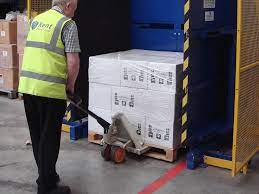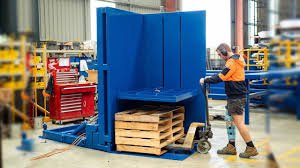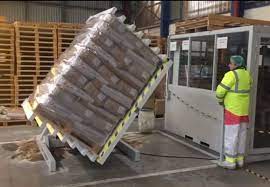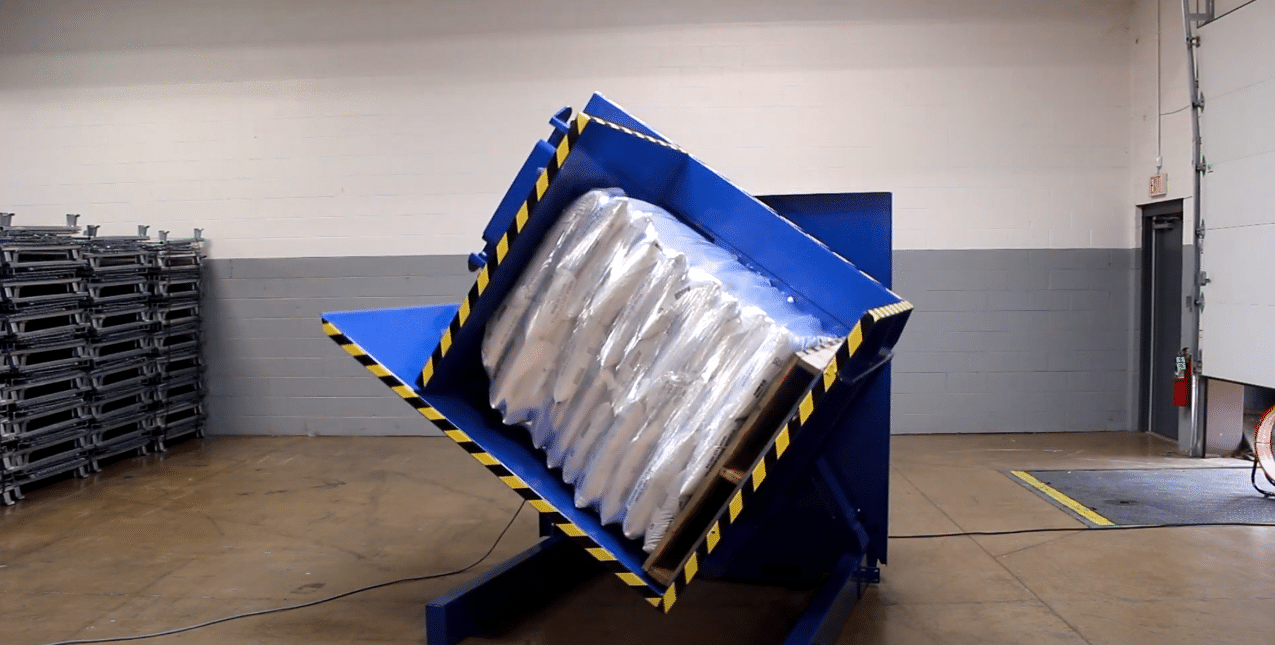What’s the ROI of Automated Pallet Changing Machines in Russia's Rugged Sector?
In Russia's demanding industrial sectors, from steel mills to chemical plants, every operational step is under pressure. Manual pallet handling is often a major weak point. It's slow, physically taxing on your workers, and creates a constant risk of product damage and workplace injuries. I have seen firsthand how these bottlenecks can stall an entire production line, causing delays that ripple through the supply chain. You are likely facing the same struggle, where inefficient manual processes are silently eating into your profits and exposing your company to unnecessary risks. The real problem is that these small, daily inefficiencies add up to a significant competitive disadvantage over time.
The Return on Investment (ROI) for an automated pallet changing machine in Russia's rugged sector is typically realized within 18 to 36 months. This calculation is based on direct labor cost reductions, a significant decrease in product damage during handling, and a measurable increase in production line uptime. For industries where products are heavy and operational conditions are harsh, the financial and safety benefits make automation a strategic and profitable decision.

I understand that a machine like this is a significant capital investment. You need to present a solid business case. You need to see the numbers and understand exactly where the value comes from. Early in my career as an engineer, and later as a factory owner, I learned that every equipment purchase must be justified by its contribution to the bottom line. It's not just about buying a machine; it's about investing in a solution that solves real problems. So, let’s break down the tangible benefits and explore how this technology pays for itself, especially in a challenging environment like Russia's industrial heartland.
How do automated pallet changers directly impact labor costs and efficiency?
Your team is your most valuable asset, but are you using their skills effectively? In many plants, I see skilled operators or technicians assigned to the strenuous, repetitive task of manually transferring goods from one pallet to another. This is not only a poor use of their talent but also a continuous drain on your payroll for a low-value activity. This situation creates a hidden cost. Every hour a skilled worker spends on manual labor is an hour they are not focused on quality control, process improvement, or maintaining critical machinery. This constant risk of injury from heavy lifting also hangs over your operations, threatening downtime and potential compensation costs. You are essentially paying skilled-worker wages for a task that creates a bottleneck and adds risk.
Automated pallet changers directly impact labor costs by allowing you to reassign two to three manual laborers per shift to more valuable, skilled tasks. This often translates into direct labor savings of over $100,000 annually per machine. At the same time, these machines can increase pallet handling efficiency by as much as 500%, slashing the time it takes to complete a transfer and feeding your production line without interruption.

The Real Math Behind Labor Savings
When we talk about labor costs, it’s not just the hourly wage. The true cost includes benefits, insurance, payroll taxes, and overtime. Then there are the indirect costs: the time and money spent on recruiting, training, and supervising these manual handling teams. Employee turnover in such physically demanding jobs is often high, which means you are constantly repeating this expensive cycle. Automation breaks this cycle. The machine doesn't get tired, require training for new hires, or call in sick. It performs the same task with the same precision every time. I remember working with a client who ran a large steel wire factory. They had a dedicated team of four people on each of their three shifts just for moving coils from production pallets to shipping pallets. The work was slow and a common source of back injuries. After we installed a single automated coil tilter and palletizing system, they were able to reassign those twelve workers. Some were trained as quality inspectors for the packaging line, while others became maintenance assistants for the entire facility. The company not only saved a huge amount on labor but also saw their product defect rate fall because they now had more eyes on quality.
From Bottleneck to High-Speed Throughput
Efficiency is about more than just speed; it's about flow. Manual pallet changing is an unpredictable stop in an otherwise smooth process. The time it takes can vary based on the crew, the weight of the load, and simple human fatigue. An automated pallet changer transforms this unpredictable stop into a fast, consistent, and predictable step. A task that might take two workers five to ten minutes to complete manually can be done by a machine in 60 to 90 seconds. Think about what that means for your overall output. If your line produces one pallet every six minutes, a five-minute manual changeover means your line is idle for most of that time. You are losing potential production. By cutting that changeover time to one minute, you gain four minutes of productive capacity for every single pallet. Over a year, that adds up to a massive increase in total throughput without changing anything else in your production process.
Comparing Manual vs. Automated Handling
| Metric | Manual Pallet Changing | Automated Pallet Changing |
|---|---|---|
| Labor Requirement (per shift) | 2-4 operators | 1 supervisor (part-time monitoring) |
| Cycle Time (per pallet) | 5-10 minutes | 60-90 seconds |
| Consistency & Reliability | Variable, depends on operator | Highly consistent, 24/7 operation |
| Risk of Human Error | High (improper lifting, dropping) | Minimal |
| Training Overhead | Continuous due to turnover | One-time initial training |
| Annual Labor Cost (Example) | $120,000 - $240,000 | ~$15,000 (supervisor's allocated time) |
Every experienced factory owner or CEO has a story about a "great deal" on a new machine that ended up costing a fortune. You buy the equipment based on a promised ROI, but then the hidden costs start to appear. The spare parts are outrageously expensive and can only be sourced from the original manufacturer. You need to fly in a specialized technician for even minor issues. The machine consumes more energy than you expected. This fear is completely valid. It makes any large capital expenditure feel like a gamble. You worry that all the projected savings from labor and efficiency will be consumed by these unexpected operational and maintenance expenses, turning your smart investment into a long-term financial burden.
The hidden operational and maintenance costs of a modern automated pallet changer are minimal and, more importantly, predictable. When you partner with a transparent supplier, these costs are laid out from the start. They primarily consist of an annual preventive maintenance plan, which is typically 1-2% of the machine's initial cost, along with predictable electricity consumption and the occasional replacement of standard wear-and-tear parts like hydraulic seals or sensors, which are designed to be low-cost and widely available.

Planning for Total Cost of Ownership (TCO)
The key is to look beyond the initial purchase price and evaluate the Total Cost of Ownership (TCO). This is a philosophy I built my own factory on. A cheaper machine that breaks down constantly is far more expensive than a reliable one with a slightly higher initial price. TCO includes the purchase price, installation, energy costs, maintenance, spare parts, and operator training over the machine's entire life. A good manufacturer will provide you with a clear schedule for preventive maintenance. This is not a "hidden" cost; it is a planned investment in reliability. Just like changing the oil in your car, scheduled lubrication, calibration, and inspection of a machine prevents catastrophic and expensive failures down the road. This proactive approach is far cheaper than the cost of emergency repairs and unplanned downtime.
The Value of Smart, Non-Proprietary Design
This is an area where my background as both an engineer and a factory owner has shaped the way we build machines at SHJLPACK. I know the frustration of having a production line stopped for days while waiting for a single, proprietary part to be shipped from halfway across the world. It’s why we design our equipment using high-quality, internationally recognized components from brands like Siemens, Schneider Electric, or Festo. For a client in a place like Russia's industrial region, this is critical. It means that if a standard sensor or motor fails, your team can likely source a replacement from a local supplier in a day, not weeks. You are not locked into our supply chain for basic components. This philosophy drastically reduces your "hidden cost" risk and empowers your own maintenance team.
Breaking Down the Foreseeable Costs
To give you a clearer picture, let’s look at what the operational costs actually entail.
| Cost Category | Description | Estimated Annual Cost |
|---|---|---|
| Preventive Maintenance | A scheduled annual or semi-annual service check by a technician. Includes lubrication, inspection, and calibration. | 1-2% of the initial purchase price |
| Wear & Tear Parts | Standard components designed to wear over time, such as seals, gaskets, or belts. | $500 - $1,500, depending on usage intensity |
| Energy Consumption | Electricity to power hydraulic or electric motors. Modern systems are highly efficient, using power only during the cycle. | Varies by use, but generally low. For example, a system might use 2-5 kWh per cycle. |
| Operator/Maintenance Training | Initial training for your team on how to operate and perform basic maintenance. | Usually included in the installation package. |
These are not hidden costs. They are predictable operational expenses that you can and should budget for. They are a small price to pay for the massive uptime and reliability the machine provides.
How does automation improve workplace safety and reduce product damage?
In heavy industries like steel production or chemical manufacturing, the workplace is filled with inherent risks. Manually lifting, tilting, and moving heavy or unstable loads like steel coils, paper reels, or pallets of bagged goods is one of the leading causes of accidents. Every time a worker physically handles a pallet, you are exposed to risk. The problem is not just the immediate danger of a serious accident, but also the long-term strain on your workforce. You are constantly worried about a life-changing injury to an employee, which can lead to huge liabilities, production halts, and damage to your company's reputation. At the same time, a dropped or mishandled pallet of finished goods is not just a write-off; it is pure, unrecoverable lost profit.
Automation directly addresses these issues by removing your employees from the danger zone. Automated pallet changers handle the heavy lifting with mechanical precision and control, drastically improving workplace safety. By ensuring a smooth, secure, and controlled transfer process, these machines also reduce product damage to virtually zero, protecting both your people and your profits.

Protecting Your Most Important Asset: Your People
The most common injuries in industrial logistics are musculoskeletal disorders (MSDs). These include back strains, shoulder injuries, and hernias caused by repetitive lifting and twisting. These are not sudden accidents but the result of cumulative strain over time. The costs are immense, including medical expenses, lost workdays, and higher insurance premiums. Automation eliminates the root cause of these injuries. The machine bears the load. This creates a fundamentally safer work environment. I once visited a paper mill where two recent back injury claims from the manual pallet-wrapping station had caused their insurance rates to spike by 20%. The investment in an automated wrapper and pallet inverter was justified by the insurance savings alone, even before counting labor and efficiency gains. A safer workplace also improves employee morale and helps you retain good workers, which is a major challenge in many industrial areas.
Eliminating Costly Product Damage
How much profit do you lose each year to products damaged during in-plant handling? A forklift tine can pierce a bag of chemicals. An unstable pallet can be dropped during a manual transfer. A heavy coil can shift and damage the layers below. These incidents are often considered a "cost of doing business," but they don't have to be. An automated pallet changer handles every load with the same gentle, controlled pressure. The clamping mechanism secures the load before it is tilted or transferred, preventing any shifting or dropping. The process is smooth and engineered for stability. This level of precision is simply not possible with manual methods or standard forklifts. Reducing your product damage rate from a few percent down to near zero can add up to tens or even hundreds of thousands of dollars in saved revenue annually.
A Clear Comparison of Risk
| Risk Factor | Manual Handling / Forklift | Automated Pallet Changer |
|---|---|---|
| Primary Safety Risk | Back injuries, crushed limbs, repetitive strain | Guarding and lockout/tagout procedures |
| Injury Rate (related incidents) | High | Negligible |
| Source of Product Damage | Dropping, impact, instability, contamination | None (smooth, controlled motion) |
| Product Damage Rate | 1-3% is common | Less than 0.1% |
| Process Control | Operator-dependent, highly variable | Machine-controlled, highly consistent |
| Insurance & Liability Impact | Drives costs up | Can help lower premiums |
By investing in automation, you are not just buying efficiency. You are investing in a safer, more predictable, and higher-quality operation that protects both your people and your products.
Can these machines integrate with existing MES and IoT systems for a smarter factory?
You are actively investing in a smarter factory. You're implementing a Manufacturing Execution System (MES) to track production in real time and using IoT sensors to monitor machine health. The goal is a fully connected, data-driven operation. The last thing you need is to invest in a new piece of equipment that acts like a "dumb" machine, operating in isolation. A machine that cannot communicate with your central systems is a problem. It creates a data black hole in your production line. You can't track its efficiency automatically, you can't incorporate it into your digital workflow, and you can't use its data for the predictive maintenance strategies you're trying to build. This kind of isolated equipment actively works against your entire digital transformation goal.
Yes, modern automated pallet changers are specifically designed for seamless integration into smart factory environments. They are built for Industry 4.0. Using standard communication protocols like PROFINET, EtherNet/IP, or OPC-UA, these machines can connect directly to your existing MES and IoT platforms. This allows them to send real-time data on cycle times, machine status, and error codes, as well as receive commands directly from your central production scheduling software.

Turning a Machine into a Data Source
An integrated pallet changer is no longer just a mechanical asset; it becomes an intelligent node in your factory's information network. It is equipped with sensors that do more than just operate the machine. These sensors track motor temperature, hydraulic pressure, cycle counts, and operating hours. This data is not trapped in the machine. It is streamed directly to your central control system. This transforms the machine from a black box into a transparent part of your process. You can see its performance on the same dashboard where you monitor your main production line, giving you a complete, end-to-end view of your operations. This is essential for identifying hidden inefficiencies and optimizing your entire workflow.
Enabling True Predictive Maintenance
This connectivity is the key to unlocking predictive maintenance, which is a major goal for any modern industrial leader looking to maximize uptime. Imagine your MES logs that the clamping pressure on the pallet changer has been taking 0.5 seconds longer to build over the past week. Or that a motor's temperature is running slightly hotter than its baseline. Your system can automatically flag this and create a maintenance work order to inspect a potential hydraulic leak or a failing bearing. The repair can then be scheduled during planned downtime, before a catastrophic failure occurs that stops production. This is the difference between proactively managing your assets and reactively fighting fires. This is how you achieve 95%+ equipment uptime.
Creating a Fully Automated Workflow
Integration is what enables a truly "lights-out" logistics process. In a fully connected system, the workflow is seamless. Your production line signals the MES that a finished pallet is ready. The MES then instructs an Automated Guided Vehicle (AGV) to transport that pallet to the automated pallet changer. The pallet changer uses its sensors to confirm the pallet's arrival, performs the transfer to a shipping-grade pallet, and then signals the MES that the job is complete. The MES then directs another AGV to move the ready-to-ship pallet to the warehouse or loading dock. In this entire sequence, there is no human intervention. It is faster, less prone to error, and fully tracked. This is the ultimate goal of a smart factory, and modern pallet changers are a critical component in making it a reality.
| Integration Feature | Benefit | Relevance to Your Smart Factory Goal |
|---|---|---|
| MES/ERP Connectivity | Receive work orders, report production counts automatically. | Provides total production visibility and control. |
| IoT Sensor Data | Streams real-time data on machine health (e.g., temperature, pressure, vibration). | Creates the foundation for predictive maintenance. |
| Standard Communication Protocols | Uses industry standards (e.g., OPC-UA, PROFINET) for easy integration. | Ensures compatibility with your existing and future systems. |
| Remote Diagnostics | Allows technicians (yours or ours) to troubleshoot issues remotely. | Dramatically reduces downtime and service costs. |
Conclusion
Investing in an automated pallet changer delivers a strong ROI through labor savings, enhanced safety, and greater efficiency. It is a crucial step toward a modern, data-driven, and profitable operation.



